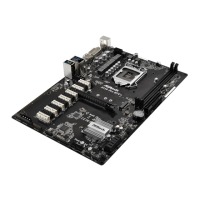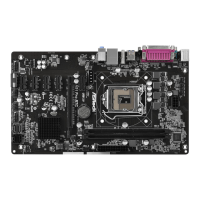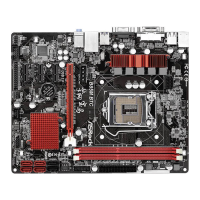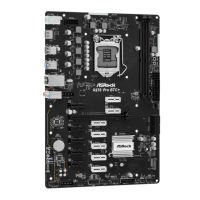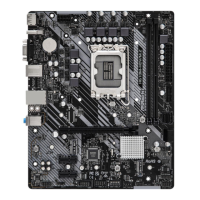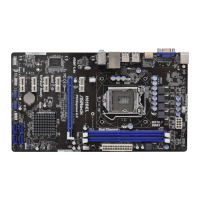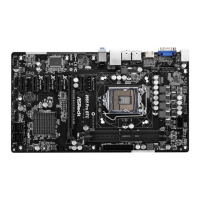
Do you have a question about the ASROCK H61 Pro BTC and is the answer not in the manual?
| Non-ECC | Yes |
|---|---|
| Memory channels | Dual-channel |
| Memory slots type | DIMM |
| Number of memory slots | 2 |
| Supported memory types | DDR3-SDRAM |
| Maximum internal memory | 16 GB |
| Supported memory clock speeds | 1066, 1333, 1600 MHz |
| Processor socket | LGA 1150 (Socket H3) |
| Processor manufacturer | Intel |
| Compatible processor series | Intel Celeron, Intel Pentium |
| Number of COM connectors | 1 |
| Number of SATA connectors | 4 |
| USB 3.2 Gen 1 (3.1 Gen 1) connectors | 0 |
| Supported storage drive interfaces | SATA II |
| USB 2.0 ports quantity | 6 |
| LAN controller | Realtek RTL8111E |
| Ethernet interface type | Gigabit Ethernet |
| Audio chip | VIA VT1705 |
| Certification | FCC, CE, WHQL, ErP/EuP |
| Component for | PC |
| Motherboard chipset | Intel® H61 |
| PC health monitoring | CPU, Power supply, Temperature |
| Audio output channels | 5.1 channels |
| Motherboard form factor | ATX |
| Windows operating systems supported | Windows 7 Home Basic, Windows 7 Home Basic x64, Windows 7 Home Premium, Windows 7 Home Premium x64, Windows 7 Professional, Windows 7 Professional x64, Windows 7 Starter, Windows 7 Starter x64, Windows 7 Ultimate, Windows 7 Ultimate x64, Windows 8, Windows 8 Enterprise, Windows 8 Enterprise x64, Windows 8 Pro, Windows 8 Pro x64, Windows 8 x64, Windows 8.1, Windows 8.1 Enterprise, Windows 8.1 Enterprise x64, Windows 8.1 Pro, Windows 8.1 Pro x64, Windows 8.1 x64 |
| OpenGL version | 4.1 |
| DirectX version | 11 |
| Maximum resolution | 2048 x 1536 pixels |
| Maximum graphics card memory | 1760 MB |
| Number of displays supported | 3 |
| Parallel processing technology support | - |
| PCI Express x1 (Gen 2.x) slots | 5 |
| BIOS type | UEFI AMI |
| ACPI version | 1.1 |
| BIOS memory size | 32 Mbit |
| Trial software | AntiVirus |
| Cables included | SATA |
| Bundled software | Google Chrome Browser, |
| Depth | 173 mm |
|---|---|
| Width | 305 mm |
Lists all items included in the motherboard package.
Details the technical specifications of the motherboard, including platform, CPU, memory, and graphics.
Highlights ASRock's proprietary technologies and software utilities for enhanced system performance and usability.
Illustrates and labels the physical components and connectors on the motherboard for easy identification.
Describes the rear panel connectors and ports, including USB, audio, video, and network interfaces.
Guidance on using screws to secure the motherboard to the chassis, with a warning against overtightening.
Provides essential safety guidelines and handling instructions to prevent damage during component installation.
Step-by-step instructions for correctly installing an Intel 1155-Pin CPU into the motherboard socket.
Details the process of installing the CPU cooler and fan, ensuring proper thermal interface and connection.
Instructions for inserting DDR3 memory modules into the DIMM slots for dual channel operation.
Information on available PCI Express slots and guidelines for installing expansion cards.
Steps to configure dual monitor output and surround display using onboard and add-on graphics.
Explanation of jumper configurations, focusing on the Clear CMOS jumper for system reset.
Describes various onboard connectors for SATA, USB, front panel audio, and system controls.
Instructions for installing necessary drivers and utilities from the provided support CD for system functionality.
Explains how to access and navigate the UEFI Setup Utility for system configuration.
Details the main menu selections available in the UEFI utility for system setup.
Lists and describes the keyboard shortcuts used for navigating and interacting within the UEFI utility.
Displays an overview of the system's hardware status and configuration upon entering the UEFI utility.
Provides options for overclocking the CPU and tuning system performance through various parameters.
Accesses a wide range of system configuration settings, including CPU, chipset, and peripheral options.
Settings related to the CPU, including Hyper-Threading, core control, and virtualization technologies.
Options for managing the primary graphics adapter, PCIe link speed, and onboard graphics features.
Settings for onboard audio, LAN, deep sleep states, and AC/power loss recovery behavior.
Configures SATA modes, link power management, and enables S.M.A.R.T. for hard disk monitoring.
Enables a new zero power hibernation mode for quick system resume.
Keeps email and social networks updated automatically while the computer is in sleep mode.
Manages onboard serial and infrared ports, including their addresses and enabled status.
Configures power management features, including suspend states, wake-on events, and power loss behavior.
Settings for USB controllers and legacy support, allowing configuration of USB device access.
Sets up internet connection modes and selects the server for UEFI firmware downloads.
Monitors critical system hardware parameters like CPU/motherboard temperature and fan speeds.
Configures boot device priority, fast boot options, and boot failure handling.
Manages system passwords, user access levels, and Secure Boot settings for enhanced protection.
Options to save or discard configuration changes and load default UEFI settings before exiting.
Information on supported operating systems and general guidance for OS installation on the motherboard.
Details the contents of the support CD, including essential drivers and useful system utilities.
Guide for installing operating systems on large HDDs (>2TB) using UEFI BIOS features.


